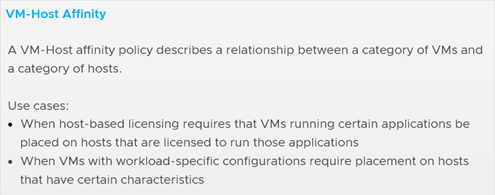VMware Cloud Professional 2V0-33.22 Exam Practice Test
Which VMware technology ensures availability of the VMs in your SDDC and uses multiple ESXi hosts to provide rapid recovery from outages and cost-effective high availability for applications? (Select one option)
Answer : B
The VMware technology that ensures availability of the VMs in your SDDC and uses multiple ESXi hosts to provide rapid recovery from outages and cost-effective high availability for applications is B. vSphere HA. vSphere HA is an agentless cluster-level availability solution that enables rapid recovery from outages and cost-effective high availability for applications. vSphere DRaaS, vSphere DPM, and vSphere eDRS are not suitable for this purpose.
A cloud administrator is asked to evaluate a number of disaster recovery solutions for the business. The current on-premises environment Is built around the latest version of VMware vSphere 7.0.
The following requirements must be met:
* Follow an on-demand cloud consumption model
* Must be a managed offering
* Deliver a recovery point objective (RPO) of no more than 30 minutes
* Rapid power-on of recovered virtual machines/ assuming cloud capacity availability
* Must accommodate for single region failure
Which solution would meet these requirements?
Answer : A
VMware Cloud Disaster Recovery is a managed disaster recovery-as-a-service offering that is built on the latest version of VMware vSphere 7.0. It provides an on-demand cloud consumption model, allowing administrators to rapidly power-on recovered virtual machines in the cloud, assuming cloud capacity availability. Additionally, VMware Cloud Disaster Recovery delivers a recovery point objective (RPO) of no more than 30 minutes, and can accommodate for single region failure.
Publishing Applications with VMware Horizon 7
https://vcdx.vmware.com/content/dam/digitalmarketing/vmware/ru/pdf/techpaper/vmware-horizon-7-application-publishing.pdf
https://www.vmware.com/pdf/techsupportguide.pdf
VMware Technical Support Guide
https://www.vmware.com/pdf/techsupportguide.pdf
https://techzone.vmware.com/resource/quick-start-tutorial-vmware-dynamic-environment-manager
Quick-Start Tutorial for VMware Dynamic Environment Manager ...
https://techzone.vmware.com/resource/quick-start-tutorial-vmware-dynamic-environment-manager
A cloud administrator Is tasked with deploying two virtual machines (APP01 and APP02) to a software-defined data center (SDDC) with multiple clusters hosted In VMware Cloud on AWS based on the following requirements:
* APP01 and APP02 should NOT run on the same host.
* Only three hosts in the SDDC are entitled to run the software installed on these servers.
* All entitled hosts are in cluster 1.
Which two actions should the administrator take to meet these requirements? (Choose two)
Answer : B, D


When configuring Hybrid Linked Mode, what is the maximum supported latency between an on-premises environment and a VMware Cloud on AWS software-defined data center (SDDC)?
Answer : D
Hybrid Linked Mode can tolerate a time skew of up to ten minutes between the on-premises data center and the cloud SDDC. The maximum latency between your cloud SDDC and on-premises data center cannot exceed 100 msec roundtrip.
A cloud administrator Is managing a VMware Cloud on AWS environment consisting of a single cluster with six hosts. There have been no changes made to the Elastic DRS configuration.
In which two situations will Elastic DRS add another a host to the cluster? (Choose two.)
Answer : A, E
A cloud administrator needs to extend a network and requires that routing be handled at the source.
Which network segment type does VMware HCX Network Extension create in the VMware Cloud software-defined data center (SDDC) when extending the network?
A virtual machine running in VMware Cloud on AWS Is experiencing poor CPU performance. What are two steps the cloud administrator can take to troubleshoot this issue? (Choose two.)
Answer : B, E
Use the VMware vSphere Client to connect to the VMware vCenter which manages the virtual machine and examine its performance statistics. You can use charts, alarms, and events to identify CPU bottlenecks or contention.
Use the Troubleshooting Workbench in VMware vRealize Operations Cloud to look for potential evidence. You can use dashboards, alerts, metrics, logs, and recommendations to diagnose and resolve CPU performance issues.
https://docs.vmware.com/en/VMware-Cloud-on-AWS/services/vmc-aws-performance.pdf